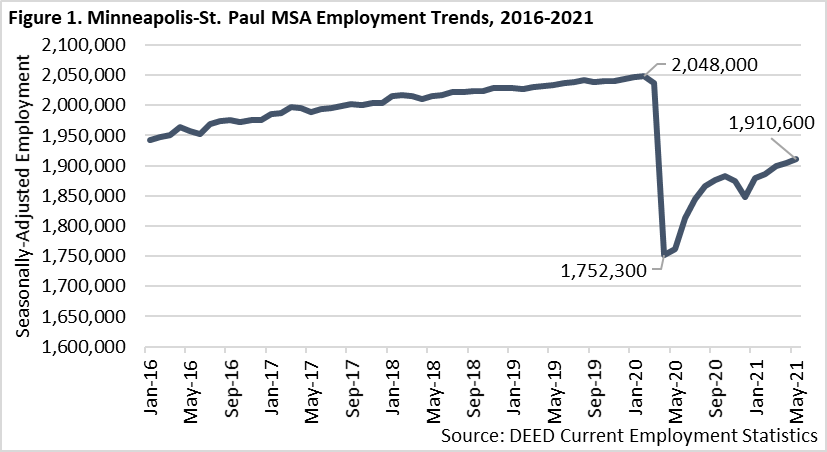 The Minneapolis-St. Paul metropolitan area is a national leader in finance, advanced manufacturing, agriculture and retailing.
The Minneapolis-St. Paul metropolitan area is a national leader in finance, advanced manufacturing, agriculture and retailing.
Medical devices, electronics and processed foods are strong suits recognized globally.
Want the freshest data delivered by email? Subscribe to our regional newsletters.
7/7/2021 9:00:00 AM
Tim O'Neill
The Minneapolis-St. Paul Metropolitan Statistical Areas (MSA) is rebounding from pandemic-induced job losses that were particularly devastating for some industries. The Twin Cities has already regained 158,300 jobs since last year, but that also means that as of May 2021, the greater Twin Cities area still has significant ground to regain to reach pre-pandemic employment.
Employment in the Minneapolis-St. Paul MSA peaked at 2,048,000 jobs in February 2020, then the region lost 295,700 jobs through April 2020. This 14.4% loss of employment was slightly more severe than Minnesota's total loss of 13.9% during that time. More than one-third (36.2%) of the MSA's total employment losses were within Leisure & Hospitality, which lost 107,000 jobs between February and April 2020. About two-thirds of the region's total employment losses (65.9%) were within Leisure & Hospitality; Trade, Transportation, & Utilities; and Education & Health Services during that time.
DEED's Current Employment Statistics (CES) data tool shows monthly nonfarm employment, wages, and hours worked by industry for the United States, Minnesota, and the Minneapolis-St. Paul MSA. Essentially, we can see how employment is coming back to the region after severe losses were experienced in early 2020. While this tool does not allow for employment analysis of just the Seven-County Metro Area, looking at the wider Minneapolis-St. Paul MSA provides us with an excellent look at how employment is trending in the region through the spring of 2021. The Minneapolis-St. Paul MSA includes the following counties in Minnesota: Anoka, Carver, Chisago, Dakota, Hennepin, Isanti, Le Sueur, Mille Lacs, Ramsey, Scott, Sherburne, Sibley, Washington, and Wright. The MSA also includes Pierce and St. Croix counties in Wisconsin.
Fortunately, the Minneapolis-St. Paul MSA has witnessed overall employment recovery in the year since April 2020. This recovery has come in two stages. First, between April and October 2020, the region regained 130,000 jobs (+7.4%). With COVID cases rising in the winter of 2020, and new safety restrictions put in place, employment in the MSA declined by 34,200 jobs (-1.8%) between October and December 2020. In the more recent second stage of recovery, between December 2020 and May 2021, the MSA has added 62,500 jobs (+3.4%) (Figure 1).

Summing up all employment gains and losses in the year following April 2020, the Minneapolis-St. Paul MSA has added 158,300 jobs (+9.0%). Through May 2021, the region has regained more than half (53.5%) of the jobs lost at the beginning of the COVID-19 pandemic. This is slightly behind the state of Minnesota, which as of May 2021 has gained back 60.0% of jobs lost at the beginning of the COVID-19 pandemic.
Over the month of May 2021, the industries witnessing the largest percentage employment increases in the Minneapolis-St. Paul MSA were:
Contact Tim O'Neill, Labor Market Analyst.